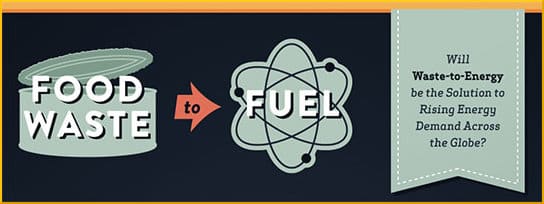
Just imagine: 1.3 billion tons is a lot of food, and that amount goes to waste around the world in a year. Not only is there no place to put so much garbage, but, come to think of it, it shouldn’t even be garbage. Here are the words of a company that intends to make a difference:
We believe converting this food waste into energy is a much more productive option than paying to dump it in landfills. RWL Water Group is currently harnessing waste-to-energy technologies at food processing facilities across the globe.
Please visit their page to see the detailed infographic that explains it all. The numbers and their implications are very thought-provoking. For instance, in one recent year for which statistics were compiled, 43 billion pounds of food were wasted in retail outlets like grocery stores, and the average American family throws out one-quarter of the food and beverages they bring home.
The part about dining out is shocking:
Restaurants throw away, on average, 1 lb/meal served. This amounts to billions of pounds of wasted food every year. 5% is wasted due to spoilage. 30% is served, but not eaten or taken home. 65% is wasted during preparation.
In both homes and restaurants, a lot of food is wasted that could be converted to bio-fuel. And there is an excellent case for making more of an effort to recapture it for that purpose. But overall, the amount of waste might not be as disgraceful as it sounds. Let’s look at the home. It is widely accepted that home cooking with fresh ingredients helps maintain healthy weight.
This is where the food waste problem collides with the obesity problem. Real cooking involves cutting off stems and peeling vegetables and discarding large lumps of fat, and so on. The paradox is, a cook who makes nourishing meals from scratch must generate more organic waste than a cook who pours everything from a can.
Even at the table, some waste is unavoidable. Some parts of what we serve as food are not meant to be eaten. A slice of melon is enjoyed, but the rind is left behind. A thick border of fat can be excised from a slice of beef and discarded with good conscience.
It’s not wrong, but it does add to the accumulation of food waste that such innovators as the RWL Water Group have decided to tackle. And even before basic staple foods get to us, a lot has been disposed of. For instance, 20% of a rice field’s harvest, as the infographic tells us, goes to waste — but those are the husks. We don’t want to eat them anyway.
Home cooking is one area where education can really make a difference. Probably, even parents who make an honest effort to produce good home cooking don’t know they are throwing away perfectly lovely parts of vegetables. They may eat beets, but do they know how delicious beet greens are, or is that extraneous foliage pitched in the trash? If people knew how to make soup like in the old days, a lot more edible bits and pieces would find their way into people’s stomachs instead of the landfill.
In the restaurant industry, it seems like the 65% wasted during preparation is worth a closer look. Of what, exactly, does it consist? Is it stems and big dollops of fat? If they are throwing away food that comes from the wholesaler in unusable condition, what is the answer to that? Because food producers and transporters can then reply, “Look, if you people don’t want spoilage or whatever, you need to get on board with this genetically modified stuff,” which opens up another huge area of debate.
If the food received by restaurants is already mostly engineered for maximum shelf life, then what is the excuse for the 65% wastage? At what stage is the damage done? And here is another paradox. According to anecdotal evidence, it might be better for the customers if the wastage rate was even higher. Everyone has heard horror stories about the uneaten bread rolls being recycled to another table, or slabs of meat picked up from the floor and dusted off.
Should a restaurant try to reduce waste by providing smaller servings, on the grounds that “they’re not going to finish it anyway”? But then the customers might take umbrage at being short-changed. And though the maître d’ might literally be a “master,” that personage cannot go around commanding the establishment’s patrons to finish everything on their plates.
How much of the organic waste is avoidable, and how much simply has to be accepted as part of the process, and dealt with in the most useful and environmentally sane way? Can this problem be addressed from both ends at the same time, both by trying to prevent at least some degree of waste, and by finding methods to turn it from a liability into an asset?
Your responses and feedback are welcome!
Source: “Food Waste to Fuel: An Infographic,” RWLWater.com, 04/02/13

 FAQs and Media Requests:
FAQs and Media Requests: 











